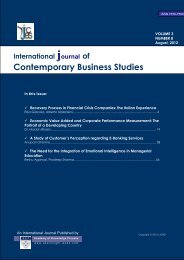Article-PDF - Academy of Knowledge Process - Webs
Article-PDF - Academy of Knowledge Process - Webs
Article-PDF - Academy of Knowledge Process - Webs
Create successful ePaper yourself
Turn your PDF publications into a flip-book with our unique Google optimized e-Paper software.
International Journal <strong>of</strong> Contemporary Business Studies<br />
Vol: 4, No: 6 JUNE, 2013 ISSN 2156-7506<br />
Available online at http://w w w.akpinsight.webs.com<br />
advantages to banks <strong>of</strong>fered by online banking such as mass customization to suit the likes <strong>of</strong><br />
each user, innovation <strong>of</strong> new products and services, more effective marketing and<br />
communication at lower costs (Tuchilla, 2000), development <strong>of</strong> non-core products such as<br />
insurance and stock brokerage as an expansion strategy, improved market image, better and<br />
quicker response to market evolution (Jayawardhena and Foley, 2000). Wise and Ali (2009)<br />
argued that many banks want to invest in ATMs to reduce branch cost since customers prefer to<br />
use them instead <strong>of</strong> a branch to transact business. The financial impact <strong>of</strong> ATMs is a marginal<br />
increase in fee income substantially <strong>of</strong>fset by the cost <strong>of</strong> significant increases in the number <strong>of</strong><br />
customer transactions. The value proposition however, is a significant increase in the intangible<br />
item "customer satisfaction". The increase translates into improved customer loyalties that result<br />
in higher customer retention and growing organization value. Internet banking is a lower-cost<br />
delivery channel and a way to increase sales.<br />
Page | 73<br />
2.4 Customer satisfaction and service quality<br />
Since customer satisfaction has been considered to be based on the customer‟s experience on a<br />
particular service encounter, (Cronin & Taylor, 1992) it is in line with the fact that service<br />
quality is a determinant <strong>of</strong> customer satisfaction, because service quality comes from outcome <strong>of</strong><br />
the services from service providers in organizations. Another author stated in his theory that<br />
“definitions <strong>of</strong> consumer satisfaction relate to a specific transaction (the difference between<br />
predicted service and perceived service) in contrast with „attitudes‟, which are more enduring<br />
and less situational-oriented,” (Lewis, 1993, p. 4-12) This is in line with the idea <strong>of</strong> Zeithaml et<br />
al (2006, p. 106-107). Regarding the relationship between customer satisfaction and service<br />
quality, Oliver (1993) first suggested that service quality would be antecedent to customer<br />
satisfaction regardless <strong>of</strong> whether these constructs were cumulative or transaction-specific.<br />
Some researchers have found empirical supports for the view <strong>of</strong> the point mentioned above<br />
(Anderson & Sullivan, 1993; Fornell et al 1996; Spreng & Macky 1996); where customer<br />
satisfaction came as a result <strong>of</strong> service quality. In relating customer satisfaction and service<br />
quality, researchers have been more precise about the meaning and measurements <strong>of</strong> satisfaction<br />
and service quality. Satisfaction and service quality have certain things in common, but<br />
satisfaction generally is a broader concept, whereas service quality focuses specifically on<br />
dimensions <strong>of</strong> service. (Wilson et al., 2008). Although it is stated that other factors such as price<br />
and product quality can affect customer satisfaction, perceived service quality is a component <strong>of</strong><br />
customer satisfaction (Zeithaml et al. 2006, p. 106-107). This theory complies with the idea <strong>of</strong><br />
Wilson et al. (2008) and has been confirmed by the definition <strong>of</strong> customer satisfaction presented<br />
by other researchers. The below figure shows the relationship between customer satisfaction and<br />
service quality. The author presented a situation that service quality is a focused evaluation that<br />
reflects the customer‟s perception <strong>of</strong> reliability, assurance, responsiveness, empathy and<br />
tangibility while satisfaction is more inclusive and it is influenced by perceptions <strong>of</strong> service<br />
quality, product quality and price, also situational factors and personal factors. (Wilson, 2008, p.<br />
78). Yang (2001) found a positive relationship between online quality service and customer<br />
satisfaction based on five dimensions <strong>of</strong> e-service quality: care/help, ease <strong>of</strong> use, reliability, and<br />
product portfolio. Mobarek (2007) in his study about e-banking and customer satisfaction proved<br />
that customers are generally satisfied with e-banking services as a whole. Nupur (2010) arrived<br />
at the conclusion that there is a relationship between customer satisfaction and in e-banking and<br />
C opyright © 2 0 13. A cademy <strong>of</strong> <strong>Knowledge</strong> P rocess
















